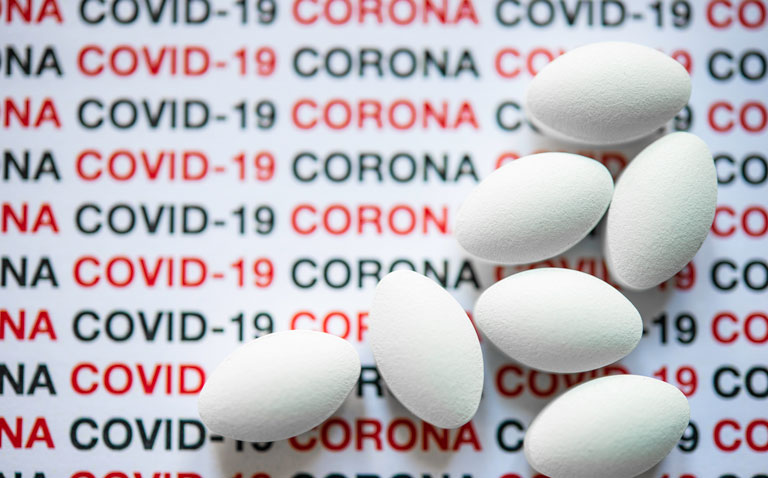In the absence of a vaccine, several recent media reports have drawn attention to the use of the anti-malarial drug chloroquine as a possible treatment for patients with COVID-19 infection.
The in vitro activity of chloroquine against severe acute respiratory syndrome caused by the SARS virus (which is related to COVID-19) was first demonstrated in 2004,1 and more recently, an expert consensus group from Guangdong province in China has endorsed use of chloroquine at a dose of 500mg twice daily for 10 days in all patients with coronavirus pneumonia.2
However, chloroquine is associated with several adverse effects. In the short-term, it has been shown to prolong the QTc interval3 whereas there is evidence to suggest that with longer-term use the drug accumulates, leading to retinal toxicity4 and myopathy.5
The value of either chloroquine or hydroxychloroquine in patients with COVID-19 remains unclear. One recent small open label study observed a synergistic effect from a combination of hydroxychloroquine and azithromycin at clearing viral load after between three and six days.6 Nevertheless, in a statement on 3 April, the International Society of Antimicrobial Chemotherapy, expressed concerns that the article did not “meet the Society’s expected standard, especially relating to the lack of better explanation of the inclusion criteria and the triage of patients to ensure safety”.7
The most recent study to explore the efficacy of chloroquine, comes from a study in Brazil. Researchers conducted a double-blind trial to assess the drug’s efficacy in hospital patients with severe respiratory syndrome secondary to COVID-19 infection.8 The study included patients aged 18 years and over who were hospitalised with a clinical suspicion of COVID-19 infection. Patients received chloroquine at a dose of either 600mg twice daily for 10 days or 450mg twice daily on day 1 and then 450mg daily for 4 days. In addition to chloroquine, patients were also given azithromycin (500mg daily for 5 days) and oseltamivir 75mg twice daily for 5 days when influenza infection was suspected.
The primary outcome was a reduction in lethality (that is, death) by at least 50% in the higher dose group and was due to be assessed after 28 days. The study had intended to enrol 440 patients but had only recruited 81 (41 to the higher dose, 40 the lower dose) before the data safety monitoring board terminated the trial. After 13 days, 39% (16/41) patients in the high dose group died compared with 15% (6/40) in the low dose group. The high dose group also experienced more instances of QTc prolongation (18.9% vs 11.1%). Overall, the risk of death was 3.6 times higher in the high dose group, a result that was statistically significant. However, after adjusting for patient age, the risk reduced to 2.8 and was no longer significant. Based on these finding, the study group decided to immediately interrupt the high dose group and all patients were switched to the low dose.
The authors concluded that “no apparent benefit of CQ [chloroquine] was seen regarding lethality in our patients so far”.
While this trial was interrupted at an early stage, the results should be seen as a warning that chloroquine (and probably hydroxychloroquine) are not the purported wonder drugs for those with COVID-19. Whether several of the ongoing clinical trials (see example in reference 8) will provide a more definitive answer of the value of chloroquine in those with severe COVID-19, remains to be seen.
References
- Keyaerts E et al. In vitro inhibition of severe acute respiratory syndrome coronavirus by chloroquine. Biochem Biophys Res Commun 2004;323(1):264-8.
- Guangdong Provincial Department of Science and Technology and Guangdong Provincial Health Commission Multi-center Collaborative Group of Chloroquine Phosphate for the Treatment of New Coronavirus Pneumonia. Expert consensus on the treatment of new coronavirus pneumonia with chloroquine phosphate. Chinese Journal of Tuberculosis and Respiratory Diseases 2020;43:185-8.
- Silva JA, Silva MB, Skare TL. Chloroquine and QTc interval. Clin Exp Rheumatol 2007;25(5):795.
- Kazi MS et al. Delayed onset chloroquine retinopathy presenting 10 years after long-term usage of chloroquine. Middle East Afr J Ophthalmol 2013;20(1):89-91.
- Casado E et al. Antimalarial myopathy: an undiagnosed complication? Prospective longitudinal study of 119 patients. Ann Rheum Dis 2006;65(3): 385-90.
- Gautret P et al. Hydroxychloroquine and azithromycin as a treatment of COVID-19: Results of an open-label non-randomized clinical trial. Int J Antimicrob Agents 2020; Mar 20 [Online ahead of print].
- Voss A. Statement on IJAA paper. www.isac.world/news-and-publications/official-isac-statement (accessed May 2020).
- Silva Borba MG et al. Effect of high vs low doses of chloroquine diphosphate as adjunctive therapy for patients hospitalised with severe acute respiratory syndrome coronavirus 2 (SARS-CoV-2) infection. A randomized clinical trial. JAMA Netw Open 2020;3(4.23):2e208857
- ClinicalTrials.gov.ChloroquineDiphosphateinthePreventionofSARSinCovid-19Infection(CloroCOVID19II). https://clinicaltrials.gov/ct2/show/NCT04342650?term=NCT04342650&draw=2&rank=1 (accessed May 2020).










